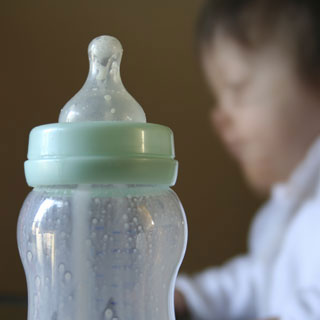Return to: Choosing a Breast Pump
BPA Plastic Baby Bottle Concerns

Bisphenol A (abbreviated BPA) is a chemical found in polycarbonate plastic. It is a shatter-resistant and clear material used in a variety of products such as plastic bottles, bicycle helmets, eyeglasses and sports safety equipment, as well as components of lifesaving medical devices such as incubators and kidney dialysis machines. It is also used to make durable epoxy resins, materials used as the coating in most food and beverage cans, to help preserve the safety and totality of our current food supply.
Recently, there was a complaint filed by a California resident whose newborn son was born with a defect that has been documented to arise from high levels of BPA found in the urine of lab rats. Based on the complaint, environmental groups have taken a stance against the sell of any plastic containing BPA sold to the public.
The highest concern, of course is the safety of infants and toddlers who could be receiving trace amounts of BPA each time they drink from their baby bottle or sippy cup, especially if the bottle or cup has been heated. To find out if a plastic container has been manufactured with bisphenol A simply look on the bottom for the recycle symbol containing the number 7, which indicates the chemicals usage.
According to the Juvenile Products Manufacturers Association (JPMA) the non-profit organization that currently represents the leading baby bottle manufacturers in the United States, there is no scientific evidence proving BPA is harmful to children. The controversy here seems to question the amount of BPA that will cause harm or defects if humans are exposed.
There are bottle options available that do not put infants and toddlers at risk to the exposure of BPA. Glass, stainless steel and new BPA-free plastic bottles are quickly rising in sales due to the recent concern. However, it is still yet to be proven that the chemical make-up of these containers are not just as risky as the older plastic alternative.
Research shows that although bisphenol A can contribute to human defects and is carcinogenic if consumed or exposed to at high levels. The amount of BPA that a person is exposed to is detected though human blood, urine, sweat or breastmilk. It is accurate that the level considered to cause harm has been found in certain human urine samples during experimentation. It is true that once BPA becomes processed in the body it combines with glucronic acid forming bisphenol A-glucuronide, changing the chemical makeup and leaving it biologically inactive according to a report by the National Toxicology Program (NTP).
Therefore, the verdict is still out on whether or not BPA bottles will remain on American shelves or banned from consumption. More and more research is being done everyday to further the knowledge of the subject and soon a decision will be made. In the meantime, resources are available on the web to conduct and formulate a well-educated decision.
If you are concerned about the potential dangers associated with BPA and would like to limit your family’s expose to the chemical, we recommend that you check out the BPA Free Products that we offer at Breast Pumps Direct.
Return to: Choosing a Breast Pump



